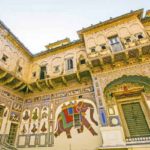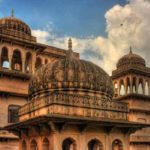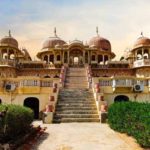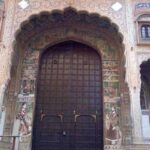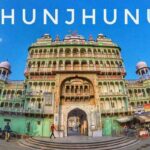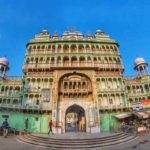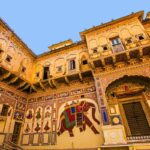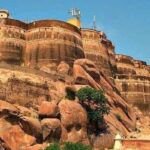Top 10 Places to Visit in Mandawa is a charming town located in the Shekhawati region of Rajasthan, India. Known for its rich cultural heritage and splendid architecture, Mandawa is a popular destination for those seeking to immerse themselves in the history and beauty of Rajasthan.
One of the main attractions of Mandawa is its magnificent havelis, or traditional mansions. These havelis are adorned with exquisite frescoes, showcasing intricate designs and vibrant colors. Each haveli tells a story through its artwork, depicting scenes from mythology, historical events, and everyday life. Walking through the narrow lanes of Mandawa, visitors can marvel at havelis like Murmuria Haveli, Goenka Double Haveli, and Hanuman Prasad Goenka Haveli, among others, and witness the remarkable craftsmanship of the bygone era.
At the heart of Mandawa lies the Mandawa Fort, a majestic structure that dominates the town’s skyline. The fort boasts impressive architecture and intricate carvings, reflecting the grandeur of its past. Today, the fort has been converted into a heritage hotel, offering visitors a chance to experience the regal lifestyle of the bygone era while enjoying modern amenities Rajasthan Budget Tours.
Mandawa Bazaar is another bustling attraction in the town, where visitors can explore a vibrant market filled with traditional handicrafts, textiles, and paintings. This bustling marketplace provides an excellent opportunity to interact with the locals and immerse oneself in the local culture.
Apart from the havelis and the fort, Mandawa is also home to several other architectural gems. The Gulab Rai Ladia Haveli, Jhunjhunwala Haveli, and Saraf Haveli are just a few examples of the stunning buildings that showcase the town’s rich architectural heritage.
For those seeking spiritual solace, Mandawa offers the Thakurji Temple, a beautiful Hindu temple dedicated to Lord Krishna. Adorned with intricate carvings and paintings, the temple is a serene place for reflection and devotion.
In addition to the architectural wonders, Mandawa is also known for its cultural festivals and events. The town comes alive during festivals like Gangaur and Teej, where locals dress in traditional attire, perform folk dances, and celebrate with great enthusiasm.
Mandawa, with its mesmerizing havelis, grand fort, bustling bazaar, and rich cultural heritage, offers a captivating glimpse into Rajasthan’s glorious past. Exploring this historic town is like stepping back in time, where every nook and corner is filled with tales of valor, artistry, and cultural traditions. Whether you are an architecture enthusiast, history buff, or simply someone seeking a unique travel experience, Mandawa Tour is a destination that will leave an indelible mark on your heart.
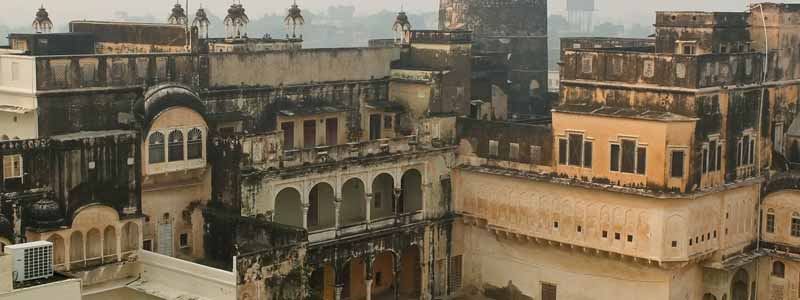
Mandawa Fort
Mandawa Fort, located in the heart of Mandawa town in Rajasthan, India, is a magnificent structure that stands as a testament to the regal heritage of the region. Built in the 18th century by the Rajput ruler Nawal Singh, the fort showcases a blend of Rajput and Mughal architectural styles, making it a remarkable sight to behold.
The fort is strategically positioned on a hilltop, offering panoramic views of the surrounding town and the desert landscape beyond. As visitors approach the fort, they are greeted by its imposing entrance gate, which is intricately carved and embellished with ornate designs. The grandeur of the fort becomes even more evident as one enters its premises.
Inside the fort, one can explore its various courtyards, palaces, and galleries. The architecture of the fort is characterized by ornate facades, beautiful arches, and delicate frescoes. The walls and ceilings of the fort are adorned with intricate paintings depicting scenes from mythology, Rajput legends, and daily life. These frescoes are a true visual delight, with their vibrant colors and attention to detail.
One of the notable attractions within the fort is the Durbar Hall, or the Hall of Mirrors, which was once the grand reception area for the rulers. This hall is adorned with mirrors, glasswork, and paintings, exuding opulence and luxury. It provides a glimpse into the extravagant lifestyle of the Rajput rulers.
Another highlight of the fort is the Rang Mahal, or the Palace of Colors, which is a beautiful chamber adorned with frescoes in bright hues. The intricate artwork on the walls and ceilings showcases the artistic finesse of the craftsmen of that era.
Today, the Mandawa Fort has been transformed into a heritage hotel, offering guests a chance to experience the regal ambiance of the past. Staying within the fort allows visitors to immerse themselves in the history and grandeur of Rajasthan while enjoying modern amenities.
Mandawa Fort stands as a proud symbol of the town’s rich cultural heritage and architectural splendor. It attracts tourists from all over the world who are captivated by its majestic presence and the artistic treasures it holds within its walls. A visit to Mandawa Fort is not just a journey through history but also an opportunity to witness the magnificence of Rajasthan’s architectural marvels.
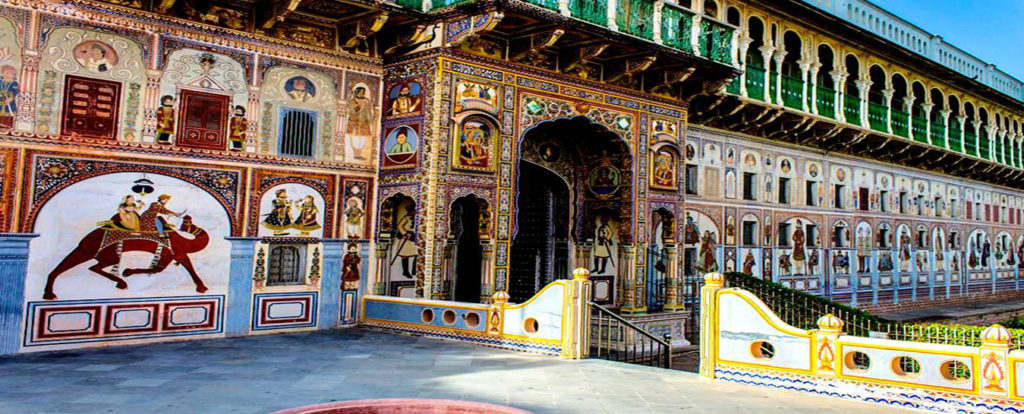
Havelis of Mandawa
The havelis of Mandawa are the crown jewels of the town, known for their exquisite beauty and architectural splendor. These traditional mansions showcase the rich artistic heritage of Rajasthan and provide a glimpse into the opulent lifestyle of the wealthy merchants who once resided in them.
The havelis of Mandawa are adorned with stunning frescoes that cover their walls, ceilings, and facades. These frescoes depict a wide range of subjects, including mythological scenes, historical events, royal processions, and everyday life. The artwork is characterized by its intricate detailing, vibrant colors, and a remarkable level of craftsmanship.
One of the most famous havelis in Mandawa is the Murmuria Haveli. It features intricately painted frescoes that narrate stories from Hindu mythology, such as the tales of Lord Krishna and the epic Mahabharata. The haveli is a visual delight, with its stunning arches, balconies, and ornate jharokhas (balcony windows).
Another notable haveli is the Goenka Double Haveli, which is renowned for its artistic brilliance. It is divided into two sections, each with its own unique frescoes. The frescoes here showcase a fusion of Indian and European artistic styles, depicting scenes of British soldiers, cars, and trains alongside traditional Indian motifs.
The Hanuman Prasad Goenka Haveli is another architectural gem in Mandawa. It is famous for its stunning frescoes that feature Lord Krishna playing the flute, surrounded by gopis (cowherd girls). The haveli’s facade is intricately carved, with exquisite floral patterns and motifs.
Apart from these, there are numerous other havelis in Mandawa that are worth exploring. Each haveli has its own distinct style and artwork, making it a delight for art lovers and history enthusiasts.
Visiting the havelis of Mandawa is like stepping into a living art gallery. It offers a unique opportunity to witness the rich heritage and cultural legacy of Rajasthan. The intricate frescoes, architectural marvels, and the grandeur of these havelis transport visitors to a bygone era of splendor and elegance. Exploring these havelis is a journey into the past, where one can appreciate the artistic prowess and craftsmanship of the artisans who created these timeless masterpieces.
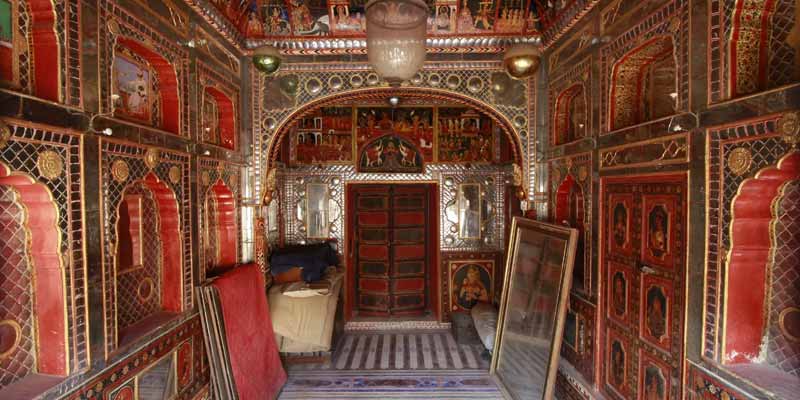
Gulab Rai Ladia Haveli
The Gulab Rai Ladia Haveli is a true gem among the havelis of Mandawa, renowned for its exceptional frescoes and architectural grandeur. It stands as a testament to the artistic brilliance and opulence of the bygone era.
Built in the 19th century, the haveli is named after its owner, Gulab Rai Ladia. It is located in the heart of Mandawa town and draws visitors with its stunning façade and intricate artwork. The haveli’s exterior is adorned with elaborate carvings and embellishments, showcasing the fine craftsmanship of the artisans.
What sets the Gulab Rai Ladia Haveli apart is its breathtaking frescoes. The walls and ceilings of the haveli are covered with vibrant paintings that depict a variety of subjects. From mythological scenes to portrayals of daily life, the frescoes offer a visual feast for art enthusiasts and history buffs alike.
The frescoes at Gulab Rai Ladia Haveli are characterized by their intricate detailing, vivid colors, and delicate brushwork. They showcase scenes from Indian mythology, such as Krishna playing the flute, Radha dancing, and celestial beings in heavenly abodes. The haveli also features depictions of animals, birds, and floral patterns, adding a touch of natural beauty to the artwork.
The haveli‘s interiors are equally captivating. The intricate woodwork, ornate arches, and decorative motifs create an ambiance of grandeur and luxury. Walking through the haveli, visitors can admire the splendid rooms, courtyards, and balconies that were once inhabited by the affluent Ladia family.
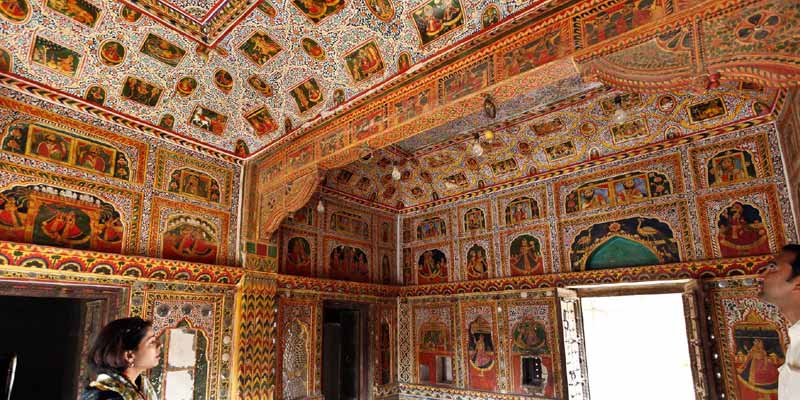
Jhunjhunwala Haveli
The Jhunjhunwala Haveli is a magnificent architectural masterpiece located in Mandawa, Rajasthan. It is one of the most famous havelis in the town, renowned for its exceptional frescoes and intricate craftsmanship.
Built in the 19th century, the Jhunjhunwala Haveli was the residence of the prosperous Jhunjhunwala family. The haveli’s exterior is a visual delight, adorned with ornate carvings, jharokhas (balcony windows), and intricately designed facades. The attention to detail and the artistic finesse displayed in the architectural elements are truly remarkable.
However, it is the stunning frescoes that truly set the Jhunjhunwala Haveli apart. The walls and ceilings of the haveli are adorned with intricate paintings that narrate stories from Indian mythology, historical events, and daily life. The frescoes are characterized by their vibrant colors, meticulous detailing, and a seamless blend of Rajasthani and Mughal artistic styles.
The artwork in the Jhunjhunwala Haveli showcases a wide range of subjects. Visitors can admire depictions of gods and goddesses, scenes from epic tales like the Ramayana and Mahabharata, and portrayals of royal processions and courtly affairs. The frescoes also feature elements of nature, such as animals, birds, and floral patterns, adding a touch of beauty and realism to the artwork.
As visitors explore the haveli, they can marvel at the grandeur of the rooms, courtyards, and balconies. The interiors are adorned with lavish decorations, including intricate mirror work, colorful glasswork, and elegant furniture.
The Jhunjhunwala Haveli stands as a living testament to the artistic and architectural heritage of Mandawa. It offers a captivating glimpse into the opulent lifestyle of the wealthy merchants of Rajasthan during the bygone era. A visit to this haveli is a journey into the rich history and cultural legacy of the region, where one can appreciate the beauty and significance of the stunning frescoes and architectural marvels that adorn its walls.
Saraf Haveli
The Saraf Haveli is a prominent architectural marvel in Mandawa, Rajasthan, known for its exquisite frescoes and historical significance. This haveli, built by the Saraf family, showcases the opulence and artistic finesse of the bygone era.
The Saraf Haveli is located in the heart of Mandawa town and is easily recognizable by its captivating façade. The haveli’s exterior is adorned with intricate carvings, beautiful arches, and ornate balconies, reflecting the architectural grandeur of Rajasthan.
What truly sets the Saraf Haveli apart is its stunning frescoes. The walls and ceilings of the haveli are adorned with vibrant paintings that depict various themes and subjects. The frescoes depict scenes from mythology, historical events, everyday life, and local legends. They showcase a remarkable level of detailing, with intricate patterns, vivid colors, and delicate brushwork.
The Saraf Haveli is also home to a small museum that further enriches the visitor’s experience. The museum houses a collection of traditional artifacts, antique furniture, and historical relics, providing insights into the cultural heritage of the region.
As visitors explore the haveli, they can marvel at the architectural elements and the intricate frescoes that adorn its interiors. The haveli’s courtyards, balconies, and rooms offer a glimpse into the lifestyle of the affluent Saraf family and the lavishness of the time.
The Saraf Haveli is not only a testament to the artistic brilliance of the past but also a significant part of Mandawa’s heritage. It represents the cultural legacy of Rajasthan and the rich history of the town. A visit to this haveli is a captivating experience that allows visitors to appreciate the architectural beauty, artistic craftsmanship, and cultural heritage of Mandawa.
Chokhani Double Haveli
The Chokhani Double Haveli is a remarkable architectural gem in Mandawa, Rajasthan, known for its intricate artwork and captivating design. It is one of the most renowned havelis in the town, attracting visitors from all over the world.
Built by the Chokhani family in the 19th century, the Chokhani Double Haveli is a double-winged mansion that showcases an exquisite blend of Rajput and Mughal architectural styles. The haveli’s exterior is adorned with beautiful frescoes, elaborate carvings, and intricately designed balconies, making it a sight to behold.
What makes the Chokhani Double Haveli truly exceptional is its breathtaking frescoes. The walls and ceilings of the haveli are adorned with vibrant paintings that depict a myriad of subjects. From mythological scenes to portraits of Rajasthani kings and queens, the frescoes narrate tales of valor, love, and history. The artwork is characterized by its fine detailing, vibrant colors, and a seamless fusion of traditional Indian motifs with European influences.
The haveli’s interiors are equally captivating. Walking through its ornate doorways and corridors, visitors can witness the grandeur of the rooms, courtyards, and balconies. The architectural elements, including intricately carved pillars, stained glass windows, and decorative arches, add to the charm and elegance of the haveli.
Harlalka Well
The Harlalka Well is a historic landmark located in Mandawa, Rajasthan, that holds great significance both in terms of architecture and water conservation. Built in the 18th century, the well stands as a testament to the ingenuity and foresight of the people of Mandawa.
The Harlalka Well is an impressive structure that served as a vital water source for the town during the arid climate of Rajasthan. Constructed with a unique architectural design, the well showcases the engineering brilliance of the time. It is a multi-story well, with several levels or ‘baoris’ built one above the other, allowing easy access to water at different depths. Each level of the well is intricately designed and embellished with ornate carvings.
What makes the Harlalka Well even more remarkable is its water conservation system. The well was designed to capture and store rainwater efficiently. It features a series of channels and filters that directed rainwater into the well, ensuring a constant supply of water even during dry seasons. The architecture of the well effectively minimized water evaporation and contamination, making it a sustainable water source for the community.
Thakurji Temple
The Thakurji Temple is a revered religious site located in Mandawa, Rajasthan. It holds immense significance for the local community and draws devotees and tourists alike with its spiritual ambiance and architectural beauty.
The Thakurji Temple is dedicated to Lord Krishna, who is worshipped as the presiding deity. The temple dates back several centuries and is considered a sacred place of worship. It stands as a symbol of faith and devotion in the heart of Mandawa.
The temple’s architecture is a blend of Rajput and Mughal styles, showcasing intricate carvings, beautiful arches, and domes. The main entrance of the temple is adorned with colorful frescoes and ornate decorations, creating a captivating visual impact. The temple complex is spacious, allowing devotees to participate in religious ceremonies and seek blessings.
Inside the Thakurji Temple, visitors can find a sanctum sanctorum or garbhagriha, where the idol of Lord Krishna is enshrined. The idol is beautifully adorned with traditional attire and jewelry, and devotees offer prayers, flowers, and other religious offerings as a mark of their devotion.
The temple comes alive during festivals and religious occasions, such as Janmashtami (the birth anniversary of Lord Krishna) and Holi (the festival of colors). During these times, the temple is decorated with lights and flowers, and devotees gather in large numbers to celebrate and participate in religious rituals.
Visiting the Thakurji Temple offers a serene and spiritual experience, allowing devotees and visitors to connect with their faith and seek solace. The temple’s tranquil atmosphere and architectural grandeur create an aura of peace and devotion.
Beyond its religious significance, the Thakurji Temple is also an architectural treasure that showcases the rich cultural heritage of Rajasthan. It stands as a testimony to the craftsmanship and artistic brilliance of the region.
Mandawa Museum
The Mandawa Museum, also known as the Mandawa Castle, is a captivating cultural institution located in Mandawa, Rajasthan. Housed within a splendid 18th-century fort, the museum showcases a rich collection of artifacts that offer a glimpse into the region’s history, art, and heritage.
The Mandawa Museum is renowned for its diverse exhibits, which include traditional Rajasthani costumes, ancient manuscripts, weapons, miniature paintings, musical instruments, and household items. These artifacts reflect the opulence and lifestyle of the wealthy merchants and nobles who once inhabited the region Top 10 Places to Visit in Mandawa.
The museum’s galleries are meticulously curated, displaying the objects in a chronological and thematic manner. Visitors can explore the different sections, each providing insights into various aspects of Rajasthani culture and history. The miniature painting collection is particularly noteworthy, featuring exquisite works that depict mythological scenes, royal courts, and everyday life.
The architecture of the Mandawa Museum is itself a sight to behold. The fort’s intricate carvings, ornate arches, and grand courtyards add to the charm and grandeur of the museum. The well-preserved interiors transport visitors back in time, allowing them to imagine the regal lifestyle of the past.
Mandawa Bazaar
Mandawa Bazaar is a vibrant and bustling marketplace located in the heart of Mandawa town in Rajasthan, India. It is a prominent commercial center and a major attraction for both locals and tourists.
The bazaar is a treasure trove of traditional Rajasthani handicrafts, textiles, jewelry, and artwork. It is famous for its exquisite artworks, including colorful paintings, embroidered fabrics, and intricate handicrafts. Visitors can explore the numerous shops and stalls that line the streets, offering a wide variety of traditional Rajasthani items.
One of the highlights of the Mandawa Bazaar is the intricate and beautifully crafted jewelry. The shops display an array of silver and gemstone jewelry, including necklaces, earrings, bracelets, and rings. The intricate designs and craftsmanship make these pieces true works of art.
The bazaar is also a haven for art enthusiasts. Paintings by local artists, depicting scenes from Rajasthani folklore, historical events, and landscapes, can be found in abundance. These paintings make for wonderful souvenirs and mementos of the vibrant Rajasthani culture.
Exploring the Mandawa Bazaar is not just a shopping experience but also an opportunity to soak in the vibrant atmosphere and witness the daily life of the local community. The bazaar is a hub of activity, with shopkeepers and artisans showcasing their skills and engaging with customers.
Visitors can also savor the local cuisine at the various food stalls and eateries in the bazaar. Rajasthani delicacies, such as dal bati churma, kachori, and ghevar, are popular choices that provide a delectable culinary experience Top 10 Places to Visit in Mandawa.

